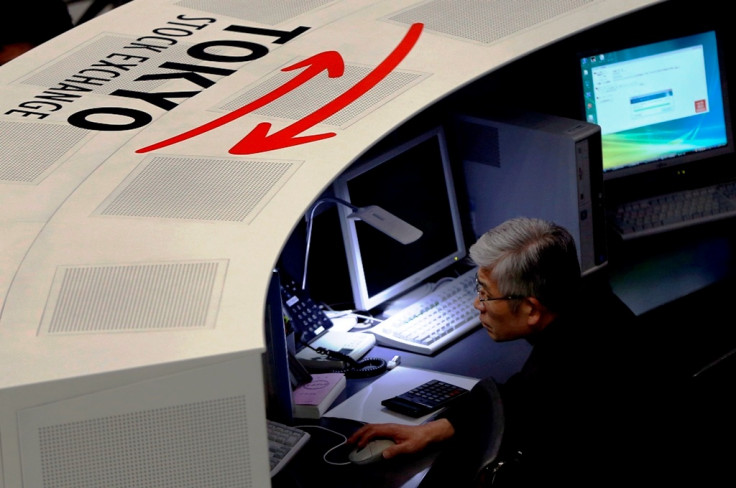Asian markets round-up: Bourses outside Japan trade lower

Asian markets outside Japan traded lower on 28 April, as investors exercised caution ahead of the US Federal Reserve's two-day policy meeting scheduled to commence later in the day.
The Japanese Nikkei finished 0.38%, or 75.63 points, higher at 20,058.95.
Australia's S&P/ASX finished 0.57%, or 34.20 points, lower at 5,948.50.
The Shanghai Composite finished 1.13%, or 51.18 points, lower at 4,476.21.
South Korea's Kospi finished 0.46%, or 9.87 points, lower at 2,147.67.
Hong Kong's Hang Seng finished 0.03%, or 9.16 points, higher at 28,442.75.
India's S&P BSE Sensex was trading 0.13%, or 34.76 points, lower to 27,142.23.
Analysts do not expect any change in the Fed's policy stance with recent US data weaker than forecast and a strong US dollar crimping exports, Reuters reported.
Market movements
In Japan, the Nikkei finished above the psychologically-important 20,000 mark, despite weak economic data. Retail sales for March dropped 9.7% on-year. They were expected to fall 7.3%, according to a Reuters poll of 17 analysts. The decline followed February's 1.8% drop.
Takuya Takahashi, a strategist at Daiwa Securities in Tokyo, told Reuters: "Heading into another peak earnings week, investors have focused on companies' efforts to raise shareholder returns."
Japanese markets will be closed for a public holiday on 29 April and the Bank of Japan will announce its interest rate decision on 30 April.
In China, the Shanghai Composite and the Hang Seng have gained some 38% and 21% respectively so far this year. Some experts believe the market movements are well-supported.
Viktor Shvets, head of Strategy Research for Asia at Macquarie, told CNBC: "There is an element of the 'Greater fool theory' in China, but there is also something fundamental going on. China is in the early stages of liquefying its economy, in both fiscal and monetary perspectives.
"China has one of the highest real interest rates, but this is going to zero. China is also capable of fiscal stimulus that other countries can't so all the improvements in the equity market can be supported not necessarily by economics, but by much more aggressive monetary and fiscal policy."
In South Korea, analysts said market players adopted a wait-and-watch approach ahead of the two-day US Federal Open Market Committee (FOMC) meeting.
In Australia, Reserve Bank of Australia (RBA) governor Glenn Stevens made a speech at The Australian Financial Review Banking & Wealth Summit in Sydney, but refused to comment on whether the central bank will cut rates given that the next policy meeting is just a week away. The RBA will announce its interest rate decision on 5 May.
Company stocks
In Tokyo, industrial robot maker Fanuc gained 3.30% on news that it had doubled its dividend payout to 60%. Fast Retailing gained 1.83%.
Komatsu lost 3.07%, pulled down by an announcement that it expects an 8.7% fall in operating profit for the fiscal year through March 2016.
Tokyo Electron tanked 14.81% following news that a merger between the Japanese firm and US-based Applied Materials fell apart owing to opposition from US anti-trust regulators.
In Shanghai, Sinopec surged 9.95% while PetroChina lost 2.18% after downplaying media reports that their parent firms will be merging. State media reported on 27 April that Beijing proposes to increase policy-directed mergers among state-owned firms, cutting the number of government-owned firms to 40.
Bank of Communications added 1.85%.
In Seoul, Samsung Electronics lost 2.08% while Samsung SDI gave up 2.70%. SK Hynix gained 2.51%.
Samsung Heavy Industries said it was not seeking a merger with Samsung Engineering. Shares in the former added 1.03% while the latter dropped 3.29%.
In Sydney, explorer Metals X shot up 6.67% after investment firm Canaccord Genuity upgraded the company's rating to "buy" from "hold", and raised its price target to A$1.75 from A$1.45.
Gold producer Newcrest Mining added 3.56% while Alacer Gold finished 2.42% higher, buoyed by overnight gains in spot gold.
This report will be updated.
© Copyright IBTimes 2024. All rights reserved.






